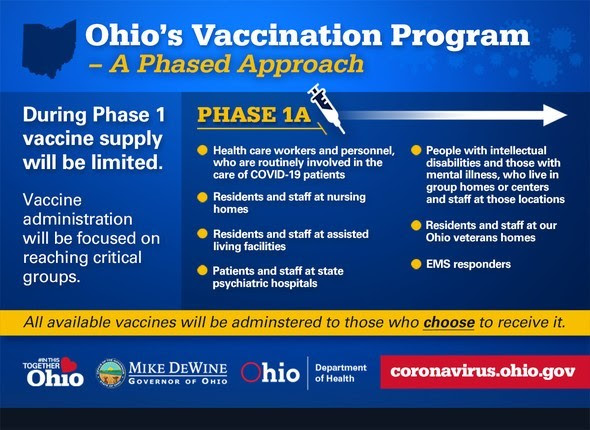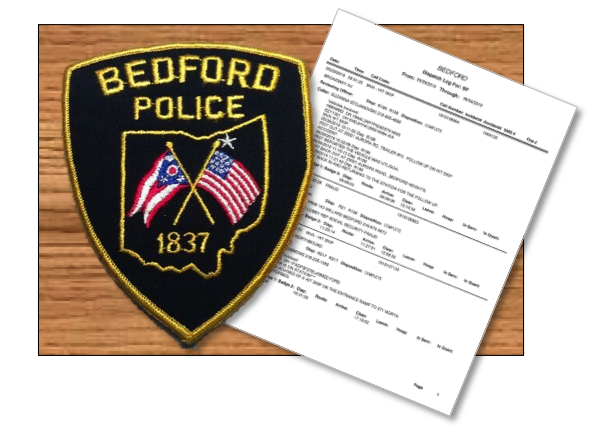COLUMBUS— Ohio Governor Mike DeWine last week announced details for Ohio’s first phase of vaccine distribution that is expected to begin today (December 15).
During Phase 1, vaccine supply will be limited, and Ohio will focus on vaccinating those who wish to be vaccinated in the critical Phase 1A groups outlined below. According to the Ohio Department of Health website, Ohio will first vaccinate those who are most at risk, including those who work in long-term care facilities, nursing homes, and other congregate-care facilities, high-risk health care workers, and first responders.
The federal government has advised that the Ohio Department of Health will not know the exact number of vaccines that will be shipped to Ohio until closer to each shipment date. The current shipment figures, which are subject to change, are as follows:
- On or around December 15, a shipment from Pfizer will include 9,750 vaccines for Ohio’s prepositioned hospital sites. According to the Department of Health website, two of the 10 prepositioned hospitals in Ohio include the Cleveland Clinic and University Hospitals in Cuyahoga County. An additional 88,725 vaccines will go to Walgreens and CVS for congregate care settings.
- On or around December 22, a shipment of 201,000 vaccines is expected from Moderna. These vaccines will go to 98 hospitals for vaccination of those who are exposed to COVID patients and to 108 health departments to vaccinate other frontline workers such as those working in emergency medical services.
- On or around December 22, another shipment is also expected from Pfizer. The tentative number of vaccines in this shipment is 123,000. These vaccines will go to Walgreens and CVS for vaccination of those in congregate care settings.
- A few days later, Ohio expects another 148,000 vaccines from Pfizer and 89,000 vaccines from Moderna.
These vaccines will be the first dose for those in the identified critical groups. A second dose will be delivered and administered in the future. It has not been determined when members of the general public will have the option to receive vaccines. As information becomes available about the next phases of vaccine distribution, it will be made public.
QUARANTINE GUIDANCE
Ohio Department of Health Chief Medical Officer Dr. Bruce Vanderhoff today discussed new quarantine guidance recently issued by the Centers for Disease Control and Prevention (CDC) for those who may have been exposed to coronavirus but are not showing symptoms.
Following the study of emerging data and a growing confidence in testing, CDC’s new guidance has two options depending on the situation:
- 10-day quarantine that does not require testing, provided there are no symptoms
- 7-day quarantine if test results are negative, provided there are no symptoms
The Ohio Department of Health, however, continues to recommend a 14-day quarantine for many citizens in Ohio.
“Staying home for 14 days after contact is still the safest way to limit possible spread of COVID-19,” said Dr. Vanderhoff. “We continue to recommend this time period for people in congregate living facilities, such as nursing homes; in workplaces with a large number of employees; and in other settings in which COVID-19 could spread extensively. We also recommend 14 days if you are in contact with people at increased risk for severe illness from COVID-19.”
For others with no symptoms, the 10-day period may be sufficient, however, Dr. Vanderhoff recommends that Ohioans consider getting tested on day eight or later to increase certainty of no infection. Quarantine can then end at the conclusion of the 10-day period.
Quarantine can be reduced further to seven days, Dr. Vanderhoff said, if an individual has no symptoms and receives a negative test on day five or later.
“In every case — whether quarantining for 14 days, or 10, or seven — maintain social distance of at least 6 feet and wear a mask when around others,” he said. “You should also keep an eye out for any symptoms for the full 14-day period. If you become sick or test positive for COVID-19, stay home and self-isolate in a separate room from others.”




